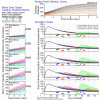Effectiveness of alternative semester break schedules on reducing COVID-19 incidence on college campuses
- PMID: 35136172
- PMCID: PMC8825861
- DOI: 10.1038/s41598-022-06260-1
Effectiveness of alternative semester break schedules on reducing COVID-19 incidence on college campuses
Abstract
Despite COVID-19 vaccination programs, the threat of new SARS-CoV-2 strains and continuing pockets of transmission persists. While many U.S. universities replaced their traditional nine-day spring 2021 break with multiple breaks of shorter duration, the effects these schedules have on reducing COVID-19 incidence remains unclear. The main objective of this study is to quantify the impact of alternative break schedules on cumulative COVID-19 incidence on university campuses. Using student mobility data and Monte Carlo simulations of returning infectious student size, we developed a compartmental susceptible-exposed-infectious-asymptomatic-recovered (SEIAR) model to simulate transmission dynamics among university students. As a case study, four alternative spring break schedules were derived from a sample of universities and evaluated. Across alternative multi-break schedules, the median percent reduction of total semester COVID-19 incidence, relative to a traditional nine-day break, ranged from 2 to 4% (for 2% travel destination prevalence) and 8-16% (for 10% travel destination prevalence). The maximum percent reduction from an alternate break schedule was estimated to be 37.6%. Simulation results show that adjusting academic calendars to limit student travel can reduce disease burden. Insights gleaned from our simulations could inform policies regarding appropriate planning of schedules for upcoming semesters upon returning to in-person teaching modalities.
© 2022. The Author(s).
Conflict of interest statement
The authors declare no competing interests.
Figures



References
-
- Montgomery D, Fernandez M. 44 Texas Students have Coronavirus After Spring Break Trip. The New York Times; 2020.
Publication types
MeSH terms
Grants and funding
LinkOut - more resources
Full Text Sources
Medical
Research Materials
Miscellaneous

